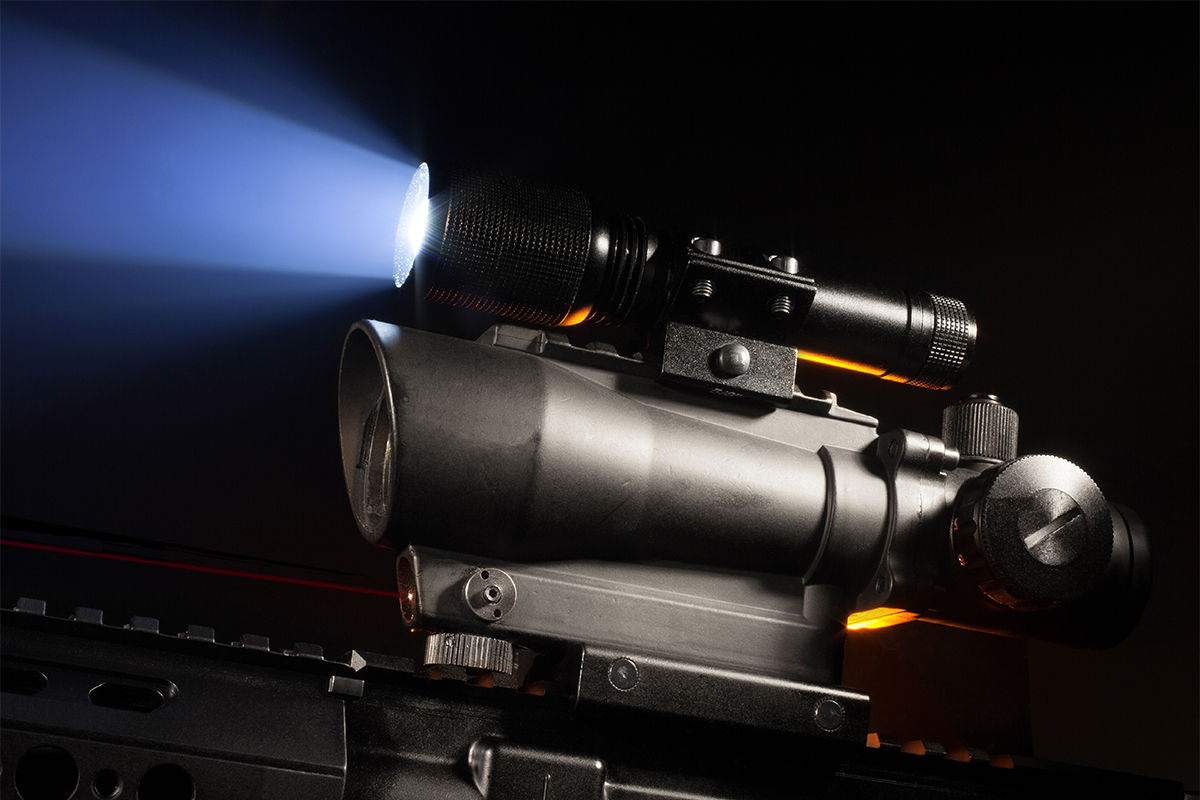
Weapon lights are designed to provide illumination in low-light or dark conditions, assist shooters in identifying targets more effectively, aid in aiming accuracy, contribute to situational awareness, and help reduce the risk of accidental engagements or misidentification of targets. The primary purpose of weapon lights is to enhance visibility in low-light conditions when traditional ambient lighting is insufficient. These lights are specifically designed to be mounted on firearms to illuminate the area in the direction the weapon is pointed. Weapon lights are particularly valuable in situations where low-light conditions prevail, such as during nighttime operations, indoor environments with poor lighting, or other scenarios where visibility is compromised. Weapon lights aid in the identification of targets. In low-light or no-light situations, it can be challenging to discern potential threats or targets accurately. The added illumination from the weapon light assists the shooter in identifying objects or individuals in the line of sight. Weapon lights contribute to accurate aiming by providing a well-lit target area. This allows the shooter to align their sights and aim precisely at the intended target. Accurate aiming is crucial for self-defense, law enforcement, military operations, and other scenarios where split-second decisions are required. Maintaining situational awareness is vital in any shooting scenario. Weapon lights help shooters remain aware of their surroundings by providing illumination beyond the firearm's muzzle. This allows the shooter to observe the environment, potential threats, and the movement of individuals or objects around them.
Weapon lights are specifically designed to be attached to firearms, including handguns, rifles, shotguns, and other types of guns. They are often integrated into the firearm's accessory rail or mounted on designated attachment points. Weapon lights are typically attached to firearms through specific mounting systems. These attachment points are designed to ensure a secure and stable connection between the light and the firearm, preventing any movement or dislodging during use. On handguns, weapon lights are commonly attached to the accessory rail located on the frame or dust cover. On long guns like rifles and shotguns, they may be mounted on the forend, handguard, or barrel, depending on the firearm's design. Weapon lights come with various mounting options to accommodate different firearms and attachment points. Weapon lights are often integrated into accessory rails, providing a seamless and integrated appearance while maintaining a sturdy connection. These may include Picatinny or Weaver rails, keymod mounts, M-LOK mounts, or other proprietary systems based on the firearm's design. In cases where a firearm may not have an integrated rail, weapon lights can be mounted on designated attachment points. These mounting points are strategically placed on the firearm to allow for the secure installation of the light. The integration of weapon lights into the firearm's design or attachment points aims to maintain the overall ergonomics and balance of the gun. This ensures that the addition of the light does not significantly alter the firearm's handling characteristics.
Weapon-mounted lights come in various types, each designed to meet specific needs and preferences of users. The different types of weapon lights cater to diverse firearm platforms, shooting scenarios, and user preferences. Rail-mounted weapon lights attach to the accessory rail (Picatinny or Weaver rail) of firearms. These lights are versatile and can be mounted on handguns, rifles, shotguns, and other firearms with compatible accessory rails. Handguard-mounted weapon lights are designed specifically for long guns like rifles and shotguns. They attach to the handguard or forend of the firearm, providing illumination forward of the muzzle. This type is common on tactical rifles and shotguns. Frame-mounted weapon lights are designed for handguns and attach to the frame or dust cover. They are commonly used on pistols and provide a compact and integrated lighting solution. These lights are often mounted on the rail beneath the barrel. Compact and subcompact weapon lights are designed for smaller handguns or concealed carry firearms. They are more streamlined and lightweight, making them suitable for smaller platforms while still providing sufficient illumination. Some firearms come with integrated lights, where the light is built into the frame or slide of the firearm. These are common on certain tactical or duty pistols and are designed to offer a seamless and integrated lighting solution. The most common type of weapon lights produces a bright, natural light similar to daylight. White light is effective for illuminating targets and surroundings. Infrared weapon lights emit light in the infrared spectrum, which is not visible to the naked eye. These lights are used in conjunction with night vision devices to maintain covert illumination in low-light or nighttime conditions. Dual-function weapon lights combine a visible light source with a laser sight. This type of light allows users to illuminate targets and engage with a laser for aiming. It provides both illumination and a aiming reference in one unit.
Weapon lights often feature user-friendly activation mechanisms. These may include push-button switches, pressure switches, or integrated controls that allow the shooter to turn the light on or off easily, depending on the situation. Push-button switches are a common and straightforward activation mechanism found on many weapon lights. These buttons are typically located within easy reach of the shooter, often near the firearm's grip or trigger guard. Pressing the button allows the shooter to turn the light on or off with a simple and direct action. Weapon lights equipped with pressure switches allow users to activate the light with minimal movement. The pressure switch is often positioned for easy access, allowing the shooter to activate the light while maintaining a grip on the firearm. Remote pressure switch lights separate the activation switch from the light itself. The switch is connected to the light by a wire, allowing users to position the switch in a convenient location on the firearm or forend. Weapon lights often feature both toggle and momentary activation modes. Toggle activation allows users to turn the light on and leave it on until manually turned off, while momentary activation briefly turns on the light as long as the switch is pressed. This versatility caters to different tactical scenarios and user preferences. Some weapon lights feature integrated controls that are seamlessly incorporated into the design of the firearm or the light itself. These controls may include switches or buttons that are easily accessible to the shooter without interfering with the handling of the weapon. Integrated controls contribute to a streamlined and ergonomic design, enhancing user-friendly operation.
Weapon lights come with various features that enhance their functionality for tactical and low-light situations. Weapon lights are designed to produce a high lumen output, providing a bright and intense beam of light. This is crucial for illuminating targets, enhancing visibility, and identifying potential threats in low-light conditions. Weapon lights are often compact and lightweight to minimize the impact on the firearm's handling and balance. This allows users to maintain control and maneuverability while benefiting from added illumination. Weapon lights are constructed with durability in mind, featuring materials and designs that can withstand recoil, impact, and harsh environmental conditions. This ensures the reliability and longevity of the light in tactical situations. Many weapon lights are designed to be water-resistant or even waterproof, allowing them to function in various weather conditions. Shock resistance is also a key feature, ensuring that the light remains operational after recoil from firearm use. Weapon lights often offer multiple light modes, including constant on, momentary activation, and sometimes strobe functions. These modes provide versatility for different tactical scenarios and user preferences. To cater to both right-handed and left-handed shooters, some weapon lights feature ambidextrous controls. This allows users to easily activate the light using either hand, enhancing accessibility and user comfort. Quick-release mounting systems facilitate easy attachment and removal of the weapon light. This feature is beneficial for quickly adapting the firearm setup or transferring the light between different firearms. Certain weapon lights feature adjustable beam focus, allowing users to switch between flood and spot beams. This adaptability is useful for different engagement distances and scenarios. To minimize glare and maintain a low profile, some weapon lights come with anti-reflection coatings on the lens, preventing the light from giving away the shooter's position.
The crucial role of LED technology in weapon lights is evident in its ability to provide efficient, powerful, and reliable illumination while offering adaptability, versatility, and advanced control features. The high efficiency of LEDs allows weapon lights to produce bright illumination without draining power quickly. The high lumen output of LEDs ensures that weapon lights can provide a bright and intense beam, improving visibility in low-light conditions. The small size of LEDs allows for the design of compact and streamlined weapon lights without compromising on lumen output. This durability of LEDs makes weapon lights reliable in various shooting and tactical scenarios. LED lights also have a longer operational lifespan, reducing the need for frequent replacements and maintenance. The directional control offered by LEDs allows for precision in beam focus and dispersion. Weapon lights can be designed to produce a focused and concentrated beam, aiding in target identification and minimizing light spill. Tactical versatility is enhanced by the ability to control the directionality of the light. LED technology enables instant illumination when power is applied. This rapid on/off capability is crucial in tactical situations where quick and precise lighting control is essential. LED technology enables the integration of advanced control features, such as remote activation, strobe functions, and momentary-on capabilities. These features enhance the overall functionality of weapon lights and contribute to their effectiveness in dynamic situations.








